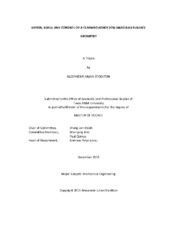| dc.contributor.advisor | Hsieh, Sheng-Jen | |
| dc.creator | Stockton, Alexander | |
| dc.date.accessioned | 2020-02-28T17:37:21Z | |
| dc.date.available | 2020-02-28T17:37:21Z | |
| dc.date.created | 2015-12 | |
| dc.date.issued | 2015-10-07 | |
| dc.date.submitted | December 2015 | |
| dc.identifier.uri | https://hdl.handle.net/1969.1/187472 | |
| dc.description.abstract | Climbing robots are ideal for situations were maintenance and inspection tasks can cause people to be in dangerous situations or require them to be present for extended periods of time. Applications include inspection, testing, civil construction, cleaning, transport and security. The focus of this thesis was on robots that used pneumatic means to attain adhesion and wheels for locomotion. Research objectives include designing or utilizing a pneumatic based adhesion method to allow the robot to stick to concrete, brick, glass, or other such surfaces; climb on a surface with the lowest possible coefficient of friction between it and the robot; have the ability to overcome a step-like obstacle while climbing; use a single body to passively transition through sharp surface changes while climbing; have the ability to traverse over a gap-type obstacle while climbing without loss of adhesion or mobility.
To complete the objectives, a test rig was created that comprised of three surfaces that were hinged together and could be locked into place using aluminum struts at the hinge joint. Different material pallets were created and adhered to plywood that was then mounted to the test rig with screws. The robot was designed and built around laser cut and 3D printed parts. From the experiments it was found that the robot could adhere to a glass surface with a coefficient of friction of 0.43 between it and the glass. Furthermore it was able to overcome a 15mm tall speedbump while climbing without loss of adhesion as well as being able to passively transition between surfaces that had an acute angle of 80° between them and do wall to ceiling transitions. Finally the robot was able to pass over a 55mm gap that was 23mm deep while climbing on a concrete surface.
It was concluded that by using thrust based adhesion the robot could handle a diverse array of surfaces and even gain greater ability to overcome obstacles while climbing. Future directions would improve on the robot by adding treads or multiple bodies to improve its base abilities. | en |
| dc.format.mimetype | application/pdf | |
| dc.language.iso | en | |
| dc.subject | Robot | en |
| dc.subject | Climbing | en |
| dc.subject | Thrust Based Adhesion | en |
| dc.subject | Irregular Surface Geometry | en |
| dc.subject | Arduino | en |
| dc.subject | Electric Ducted Fan | en |
| dc.subject | Android App. | en |
| dc.subject | Inverted Climbing | en |
| dc.title | Design, Build, and Control of a Climbing Robot for Irregular Surface Geometry | en |
| dc.type | Thesis | en |
| thesis.degree.department | Mechanical Engineering | en |
| thesis.degree.discipline | Mechanical Engineering | en |
| thesis.degree.grantor | Texas A&M University | en |
| thesis.degree.name | Master of Science | en |
| thesis.degree.level | Masters | en |
| dc.contributor.committeeMember | Kim, Won-jong | |
| dc.contributor.committeeMember | Cizmas, Paul | |
| dc.type.material | text | en |
| dc.date.updated | 2020-02-28T17:37:22Z | |
| local.etdauthor.orcid | 0000-0003-1177-8435 | |


